Cork are still in with a chance of progressing out of Munster, despite not being in action this weekend as the other four Munster counties fight it out. Cork will have their attention firmly fixed on the Gaelic Grounds - their fate now lies in the hand of others. They have undergone a transformation from their opening round defeat in Walsh Park to their latest dismantling of Tipperary, with two hectic games in Páirc Uí Chaoimh in the middle. Here we will look at how they have changed across these games.
Personnel changes/Rolling a six
Pat Ryan’s willingness to mix it up has been a real boon. The Cork manager rang the changes after the opening round defeat to Waterford, as he brought six new men into the starting line-up. Cork’s camp is a competitive place to be – a total of 26 players have seen game time across their four matches. The Cork management showed their ruthless side when they substituted Eoin Downey after 23 minutes in the Limerick game, as he had picked up a yellow card. They were making sure not to suffer the same consequences that saw Damien Cahalane and Sean O’Donoghue pick up second yellows against Waterford and Clare respectively.
One change that was forced on them came from the injury suffered by centre back Ciarán Joyce, who has made the six jersey his own in recent years with his abrasive, marauding style. His loss was one that had the potential to derail Cork, particularly for the visit of Limerick. But Rob Downey has excelled while slotting into the pivotal role.
The key thing is that he plays the role very differently to Joyce. Joyce plays the centre back role very much stepped up on his man. Waterford put him under pressure with their rotation system in their forwards. Jamie Barron caused particular damage when matched up with him, while there were also challenges posed by Kevin O’Mahony and Jack Prendergast. Joyce cut a frustrated figure as he was dragged around the Cork defence, having little positive influence on the game as he conceded three scoreable frees and also gave away penalty, resulting in a sin bin.
RM Block
Clare, in the form of David Reidy for the duration, also managed to unhinge the Cork defence as they dragged Joyce out again, and Reidy had a positive influence on the game and also left large swathes of space centrally, which Clare really capitalised on when Cork were down to 14 men.
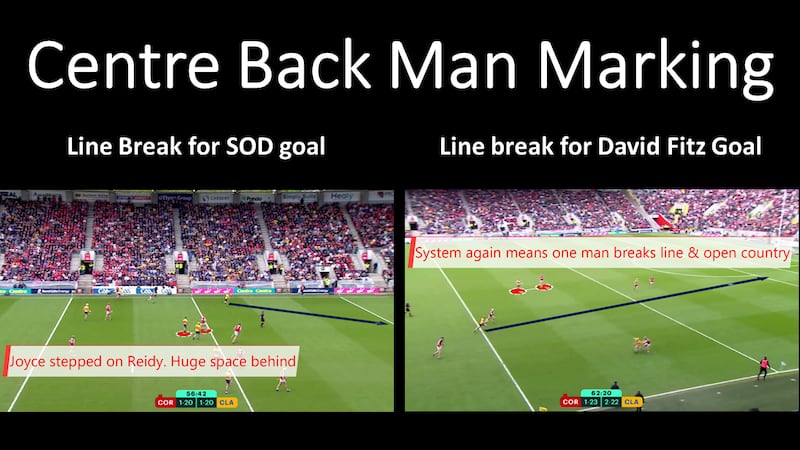
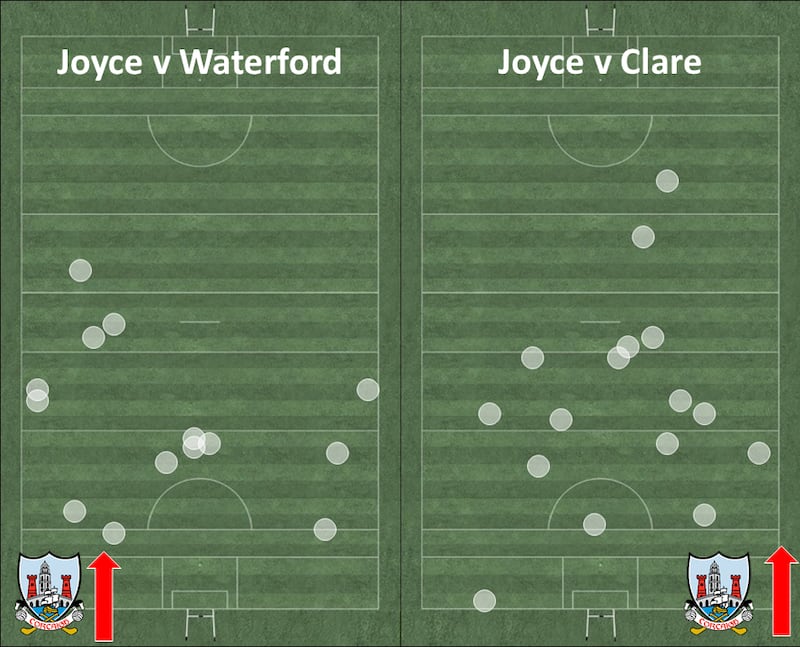
Rob Downey plays much more of a sitting role. This has led to more solidity in the Cork defence in their last two games. He is able to step up on his man in periods and also drop off at other stages. He was able to attach to Cian Lynch for periods against Limerick but at other times sat off into the pocket, protecting the full back line.
Downey had eight positive turnovers across two games, compared to only two for Joyce. He is able to control across the half back line on his terms, particularly winning puck-outs both aerially and on the ground. He won four Limerick and five Tipp puck-outs, while also aerially stopping others for other to pick up breaks.
There is also a distinct change in how they use the ball. Joyce favours carrying hard out and delivering direct ball. While Downey favours hand passes and short stick passes linking play. Yet Downey did link forward for two second half points against Tipp, when Cork’s dander was up. If Cork progress, the return of Joyce will pose some hard questions for the Cork management.
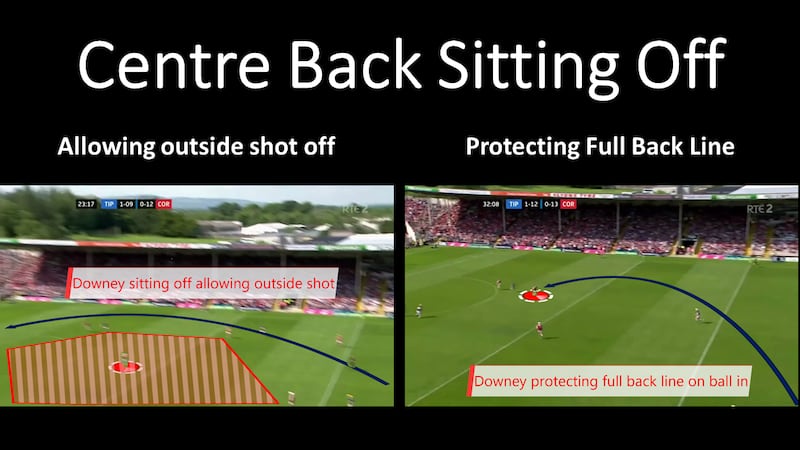
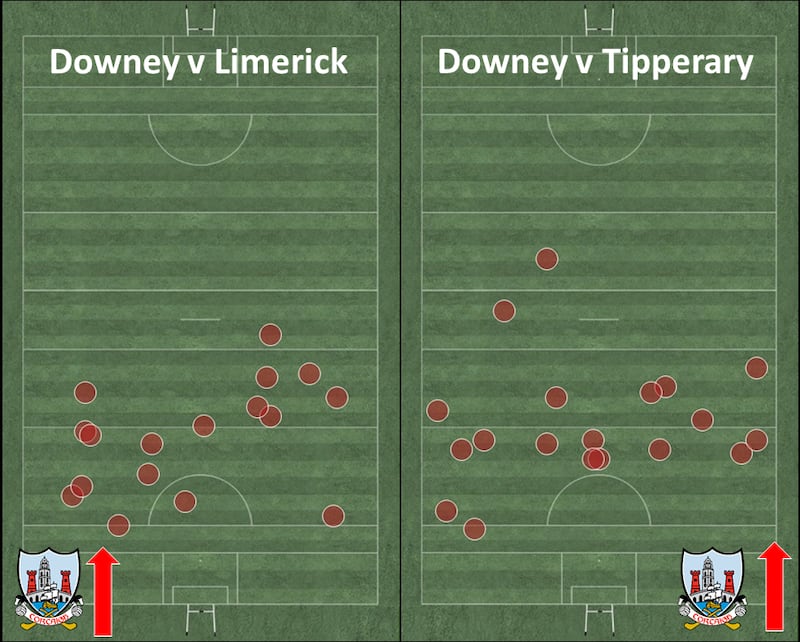
Cork puck-outs
An area where Cork really struggled in their opening two games was their own puck-out. It was highlighted here two weeks ago that they were losing the breaking ball battle on their own puck-outs heavily, only winning 8/22 (36%) against Waterford and 8/19 (42%) against Clare. They were looking to hit perfect balls to moving targets in the 10 and 12 zones.
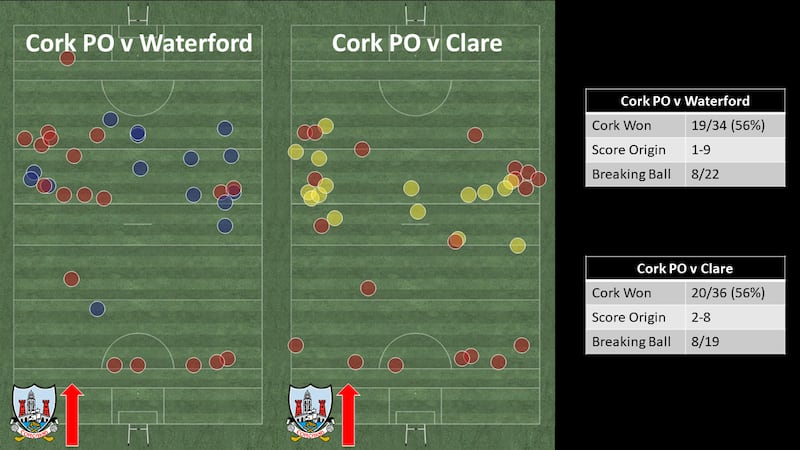
Cork have since shown a willingness to address this issue. They brought a different puck-out strategy to the first half against Limerick, as they bombarded the Limerick D with puck-outs and won 7/9 (78%) breaking balls. Cork had hard runners in front of the breaking ball zone and those competing aerially knew their role. Declan Dalton and Brian Hayes were huge aerial disrupters, with Shane Barrett mopping up breaks at pace, while Seamus Harnedy played a multi-use role. Cork managed to score 2-6 off their own puck-out in this first-half display against Limerick.
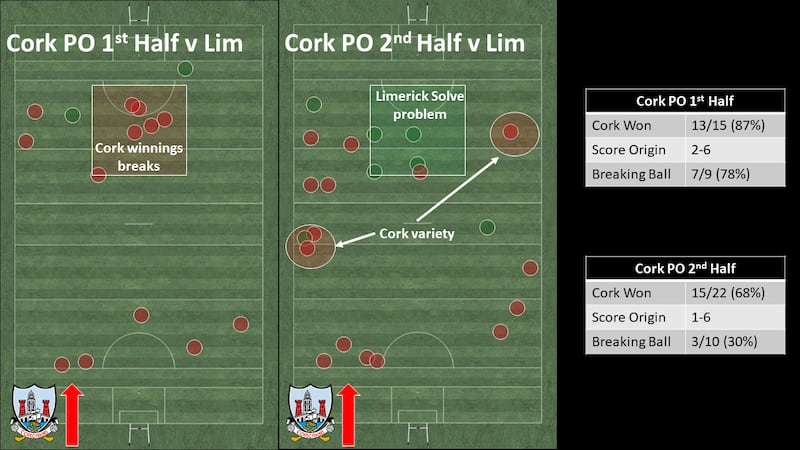
The real beauty in the Cork puck-out strategy against Limerick is they were able to mix it up in the second half, as Limerick identified the issue at half time and fixed it. Limerick went away from their rigid zonal defence as Kyle Hayes was forced to come a little more central on puck-outs and midfield dropped even further. This allowed other pockets to open, which Cork exploited.
Excellent examples are a Patrick Collins puck-out to Darragh Fitzgibbon on the run in the 12 pocket in the 40th minute and the late mid-range effort to Shane Kingston which he carried past what seemed like the entire Limerick defence before being hauled down by Kyle Hayes resulting in a penalty. The greater variety to the Cork second-half puck-out yielded a further 1-6. The Cork puck-out continued to prosper against Tipperary as they scored 2-10 off their restarts in the first half, winning 26/35 puck-outs (74%).
Forward unit
Cork are in rare form on the scoreboard, the team with most scores on average across the hurling championship. They have scored a total of 11-107 over four games, increasing each day. The whole Cork forward unit is functioning well with different players bringing different skills and attributes to the collective. Their shape allows for players to ask difficult questions of opposing defences.
The questions continue all game and come from the bench too. Over the first two games, their four mainstay forwards weren’t always contributing scores, assists and frees won but this changed in the Limerick and Tipp games. The most challenging question they are posing is how to deal with the dynamism of Shane Barrett at centre forward. He plays literally everywhere except where you would think a centre forward should be, only using it as a starting point to fan out 360 degrees. Barrett has scored 1-7, assisted 3-4 and won frees for another 0-9 so far in the championship.
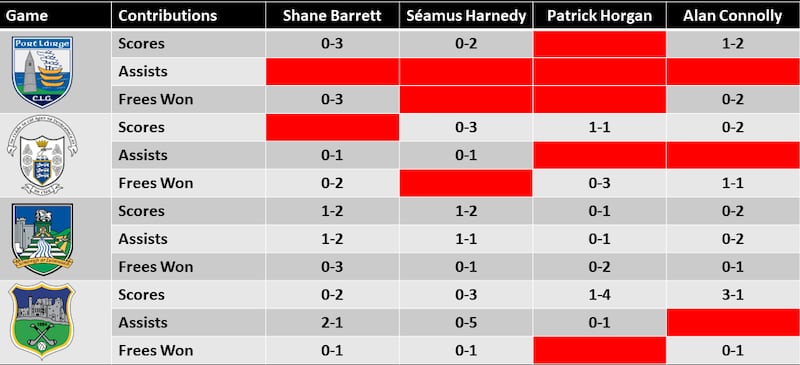
One accusation that has been levelled at Cork in recent weeks is that they are not feeding enough ball to Alan Connolly. One of the reasons he is not receiving more ball is because of how far up the pitch he stays – his starting point and lateral inside running means when he gets possession he is rarely far from the goal, which is ideal for someone who targets green flags.
He scored a wonderful hat-trick against Tipp to add to his solo effort against Waterford in the opening round. Do Cork want more ball going to him? Not necessarily so. This positioning of him, Brian Hayes and Patrick Horgan is stretching opposition defences and leaving them with huge ground to cover to help each other out.
In the last two games Shane Kingston has made an immediate impact off the bench upon his introduction – 0-4 in four minutes against Tipperary stood out. But his contribution against Limerick even more valuable - he scored a point and also won the all-important late penalty. Add the scoring prowess of Darragh Fitzgibbon to that forward unit and they really have got multiple means of hurting opponents.
A key aspect of Fitzgibbon is the midfield foil he now has in Ethan Twomey, who is foraging around that area with a focus on tackles, disruption and hard work. During the periods where Cian Lynch was midfield for Limerick, Twomey was limpet-like around him.
Of course, the way things have worked out, Cork’s fate is out of their hands now. They will be watching what unfolds this weekend with great interest, as they hope to get the chance to continue their development in the coming weeks.
Paul O’Brien is a performance analyst with The Performance Process (twitter.com/NoPlanBGAA).















